Middle East
Explosions, huge fire in Sudanese city of Port Sudan | Sudan war News
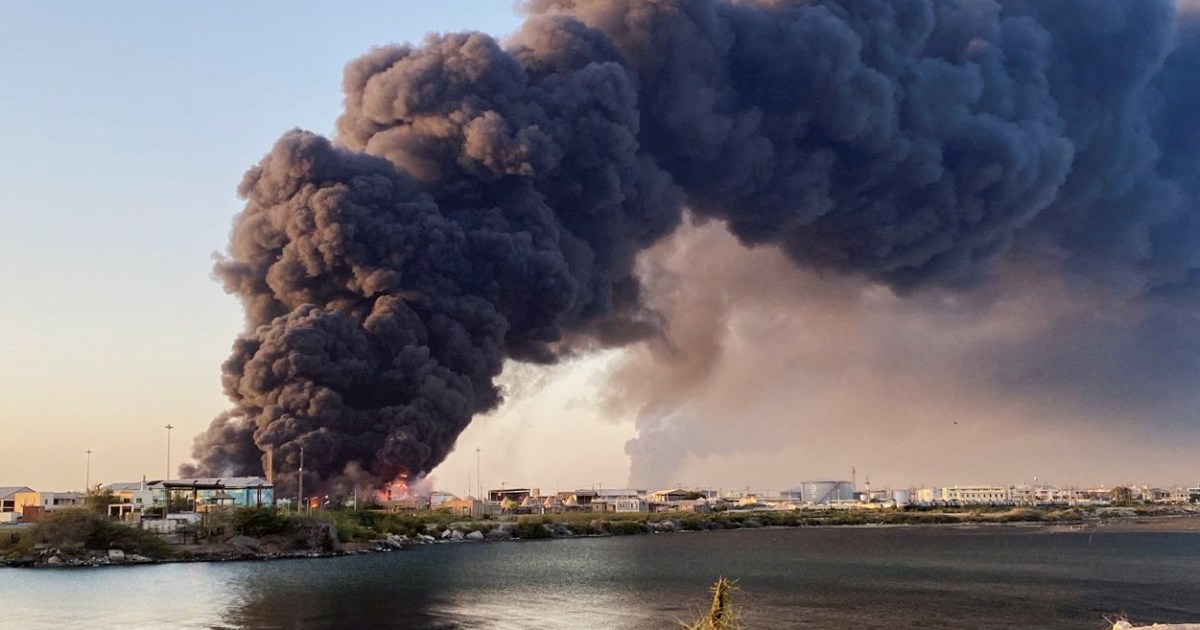
DEVELOPING STORYDEVELOPING STORY,
Drones believed to have been launched by the paramilitary Rapid Support Forces are said to have struck fuel depot causing huge fire: Reports
Multiple explosions have been heard and a huge fire seen in Port Sudan, though the exact locations and causes were unclear, as Sudan’s civil war rocks the previously quiet city for the third day.
Dark plumes of smoke could be seen emerging from the vicinity of the country’s main maritime port in the city, where hundreds of thousands of displaced people have sought refuge.
Al Jazeera’s Hiba Morgan, reporting from the Sudanese capital, Khartoum, said residents in the port city reported that attack drones launched by the paramilitary Rapid Support Forces (RSF) hit a fuel depot and other targets.
“According to the residents, they believe that it was drone strikes by the paramilitary Rapid Support Forces – once again. They targeted a fuel depot in the city but also around the port and the air base,” Morgan said.
The conflict between Sudan’s army and the RSF has created the world’s worst humanitarian crisis, one likely to be worsened by these latest attacks on Port Sudan, where the United Nations and aid agencies, as well as army-aligned government ministries, have set up headquarters.
Attacks on the Red Sea coastal city, which began on Sunday, represent a sharp escalation in fighting, as Port Sudan had remained untouched by ground or air attacks until this week.
On Sunday, a military base in the city, near the country’s only functioning international airport, was struck by drones, which was followed by the targeting on Monday of fuel depots in the city. In both cases, military sources blamed the RSF.
The attacks came after a military source said the army had destroyed an aircraft and weapons depots in the RSF-controlled Nyala airport. The RSF did not claim responsibility for the attacks.
The attacks this week drew condemnation from neighbours Egypt and Saudi Arabia, as well as expressions of concern from the UN.
The war between the army and RSF began in April 2023, triggered by a dispute over a transition to civilian government.
The conflict has displaced more than 12 million people in Sudan and pushed half the population into acute hunger, according to the UN.
Middle East
Israel has turned 70% of Gaza into no-go zones, in maps | Israel-Palestine conflict News
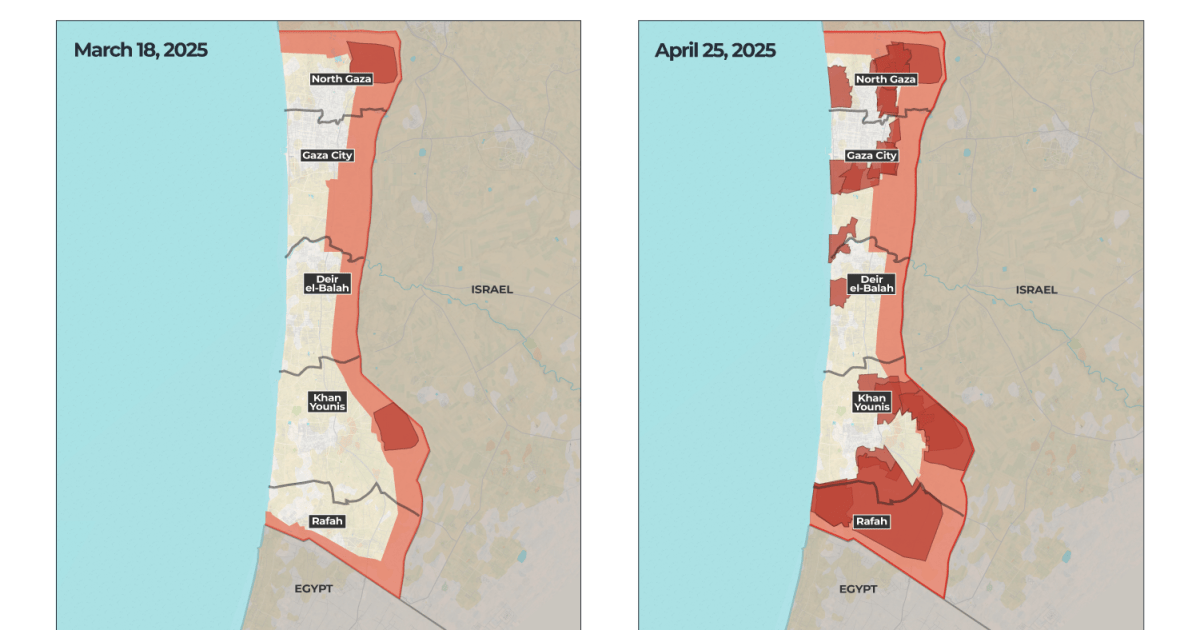
Since Israel broke the ceasefire, it has declared most of Gaza as no-go zones, forcing expulsions amid attacks and blocking of all humanitarian aid.
Israel has restricted Palestinians’ access to 70 percent of Gaza, either by declaring large areas as no-go zones or issuing forced displacement orders, according to the United Nations Office for the Coordination of Humanitarian Affairs (OCHA).
In southern Gaza, much of Rafah governorate has been declared a no-go zone, placed under forced displacement orders by the Israeli military since late March. In the north, nearly all of Gaza City is under similar orders, with only small pockets in the northwest still exempt. Entire areas east of the Shujayea neighbourhood and along the Israeli border have been declared a restricted zone.
The animated map below shows how Israel’s military has expanded its forced displacement orders since breaking the ceasefire on March 18.
Israel’s Gaza occupation plan
On Monday, Prime Minister Benjamin Netanyahu said Gaza’s more than two million people “will be moved” in a new ground offensive that will involve Israeli troops holding on to seized territory, establishing a “sustained presence” in Gaza.
This follows the unanimous approval by Netanyahu’s cabinet to call up 60,000 reservists and place the Israeli military in control of delivering food and other essential supplies to Gaza’s starving population.
Israel prioritising territorial control
Reporting from Deir el-Balah, in central Gaza, Al Jazeera correspondent Tareq Abu Azzoum said Palestinians view the Israeli ground offensive in Gaza and reoccupation of much of its territorial landscape as a form of collective punishment and an attempt to change the demographic and political map of Gaza.
Many Palestinians understand that Israel is prioritising territorial control over any political solution, and many shared their fear and panic regarding the possibility of not being able to return to their homes.
They also believe that Israel is trying not just to dismantle the military capabilities of Hamas, as the Israeli military spokesperson and Netanyahu have stated, but they are also trying to empty Gaza of its residents and to suffocate civilians.
Israel will do this by using humanitarian language alongside military tactics, including an expanded ground offensive and tightening its grip on the flow of aid to Gaza.
But there was a general and clear sentiment of defiance among many Palestinians. Social media is filled with messages of resilience and people saying they will not leave Gaza, whatever the cost.
Gaza facing ‘extreme risk of famine’
The Palestine Red Crescent Society (PRCS) says Gaza is facing “extreme risk of famine” with no food remaining in markets and aid distribution centres.
Israeli human rights group B’Tselem has accused Israel of “using starvation as a method of warfare” in Gaza. Half of those being starved by Israel are children, the prominent rights group said.
“[On] the nutritional front, the population is facing once again an extreme risk of famine,” the PRCS said in its latest situation update.

“There is an inability to meet even the minimum daily needs of over a million displaced people,” it said.
The PRCS’s food stocks allocated for displaced people are now “completely depleted”, with “limited quantities of legumes” being “distributed to community kitchens to cover some of the basic needs of displaced individuals”.
Since Israel broke the nearly two-month-long ceasefire with Hamas on March 18, its military has killed at least 2,459 Palestinians in Gaza, bringing the total number of confirmed killed in the besieged Strip to 52,567.
Middle East
No sense in Gaza ceasefire talks amid Israel’s ‘hunger war’: Hamas | Israel-Palestine conflict News
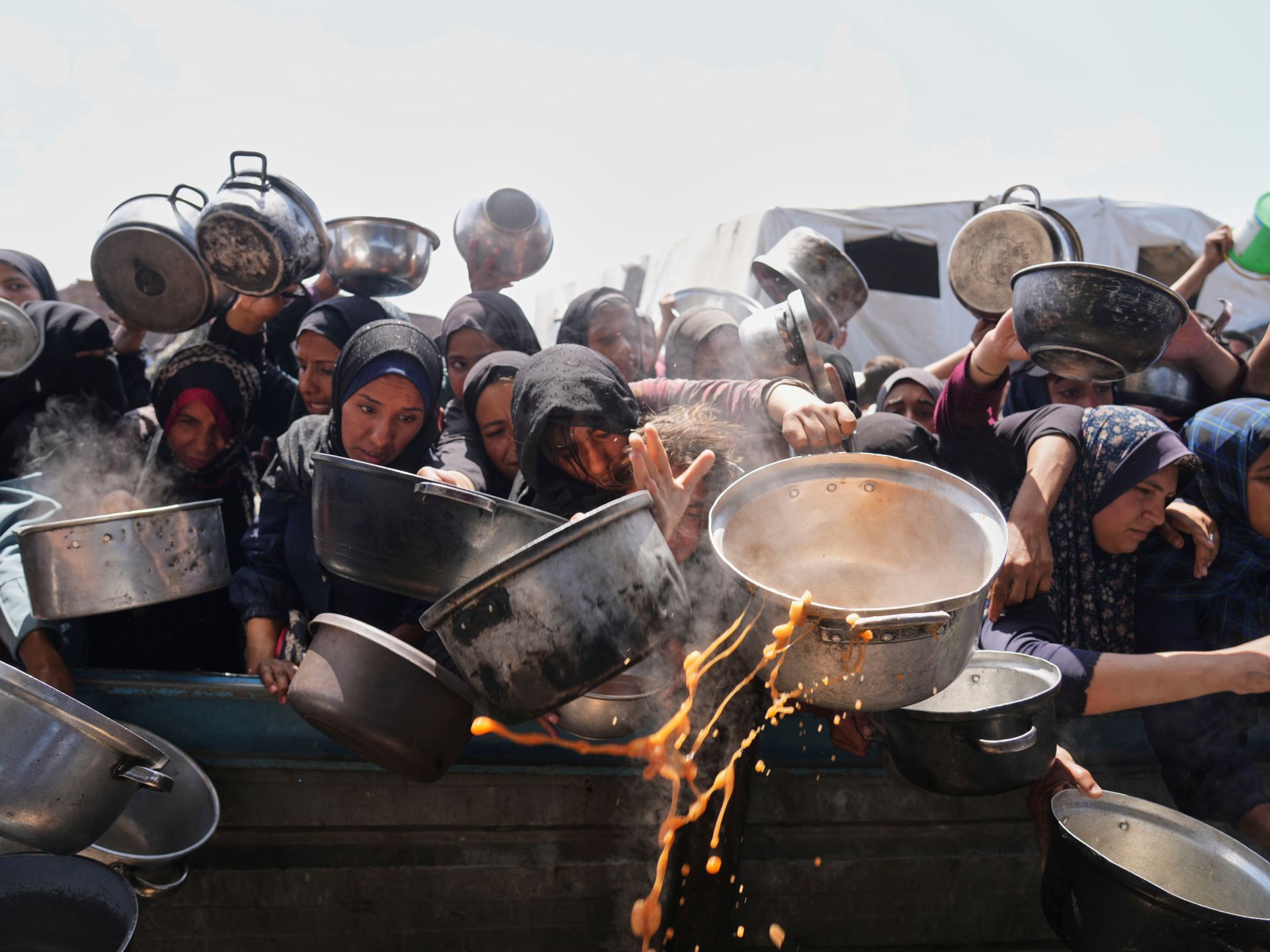
Hamas will no longer engage in ceasefire negotiations with Israel, seeing no point in doing so “as long as the hunger war and extermination war” continues on the Gaza Strip, according to the Palestinian group’s senior official.
Basem Naim told the AFP news agency on Tuesday that the international community must pressure the government of Israeli Prime Minister Benjamin Netanyahu to end the “crimes of hunger, thirst, and killings” in Gaza.
“There is no sense in engaging in talks or considering new ceasefire proposals as long as the hunger war and extermination war continue in the Gaza Strip,” he said.
Naim’s remarks came a day after Netanyahu said the population of the enclave “will be moved” in an upcoming expanded military operation by Israeli forces that would reportedly entail “the conquest of the Gaza Strip and the holding of the territories”.
Nearly all of Gaza’s 2.3 million residents have been displaced multiple times since Israel began its war on the Palestinian enclave in October 2023.
Total blockade
The humanitarian situation in the Gaza Strip has grown increasingly dire since a total blockade was imposed by Israel on March 2, causing widespread food shortages as Israel carries out deadly attacks across the enclave.
Al Jazeera’s Hind Khoudary, reporting from Deir el-Balah in central Gaza, said Palestinians are “struggling to find food to feed their children” with some “forced to eat expired or rotten food”, while others cannot find any form of sustenance.
The Palestine Red Crescent Society (PRCS) said this week that food supplies in Gaza have now “completely run out” in both local markets and humanitarian distribution centres.
“The population is once again at extreme risk of famine,” the PRCS said in its latest situation update. “There is an inability to meet even the minimum daily needs of over a million displaced people.”
According to the PRCS, only “limited quantities of legumes” are currently being distributed to community kitchens, as all previously stocked aid has been depleted.
The International Committee of the Red Cross (ICRC) echoed these concerns, calling for the immediate entry of humanitarian aid and warning against its politicisation.
“The level of need among civilians in Gaza right now is overwhelming,” said ICRC spokesperson Christian Cardon.
“Under international humanitarian law, Israel has an obligation to use all means available to ensure that the basic needs of the civilian population under its control are met,” he added.
![[Al Jazeera]](https://www.aljazeera.com/wp-content/uploads/2025/04/Interactive_Gaza_foodaid_timeline-1742987531-1744365779.webp?w=770&resize=770%2C963&quality=80)
Awad, 39, who lives in a tent in the southern Gaza city of Khan Younis, told Al Jazeera on Monday that “Israel has not stopped the war, the killing, the bombing, the destruction, the siege and the starvation – every day – so how can they talk about expanding military operations?
“I call on the world to witness the famine that grows and spreads every day,” he said.
Aya al-Skafy, a resident of Gaza City, told Al Jazeera on Monday that her baby died because of malnutrition and medicine shortages last week.
“She was four months old and weighed 2.8kg [6.2lb]. Because of severe malnutrition, she suffered from blood acidity, liver and kidney failure, and many other complications. Her hair and nails also fell out due to malnutrition.”
Israeli plans
According to leaked plans, Israel’s government reportedly wants to severely restrict the way food is distributed in Gaza and is proposing that United States companies take over distribution from the United Nations and other humanitarian agencies.
Under the plan, Palestinian families would be allowed to take one food parcel a week in designated hubs in southern Gaza, and Israel would permit 60 trucks to enter the Gaza Strip every day – just one-tenth of what’s needed, according to experts.
Aid groups in the UN have rejected this plan, saying it’s a pressure tactic to further reinforce control over life-saving supplies.
Middle East
‘Church has changed’: Will the next pope allow women to become priests? | Religion News
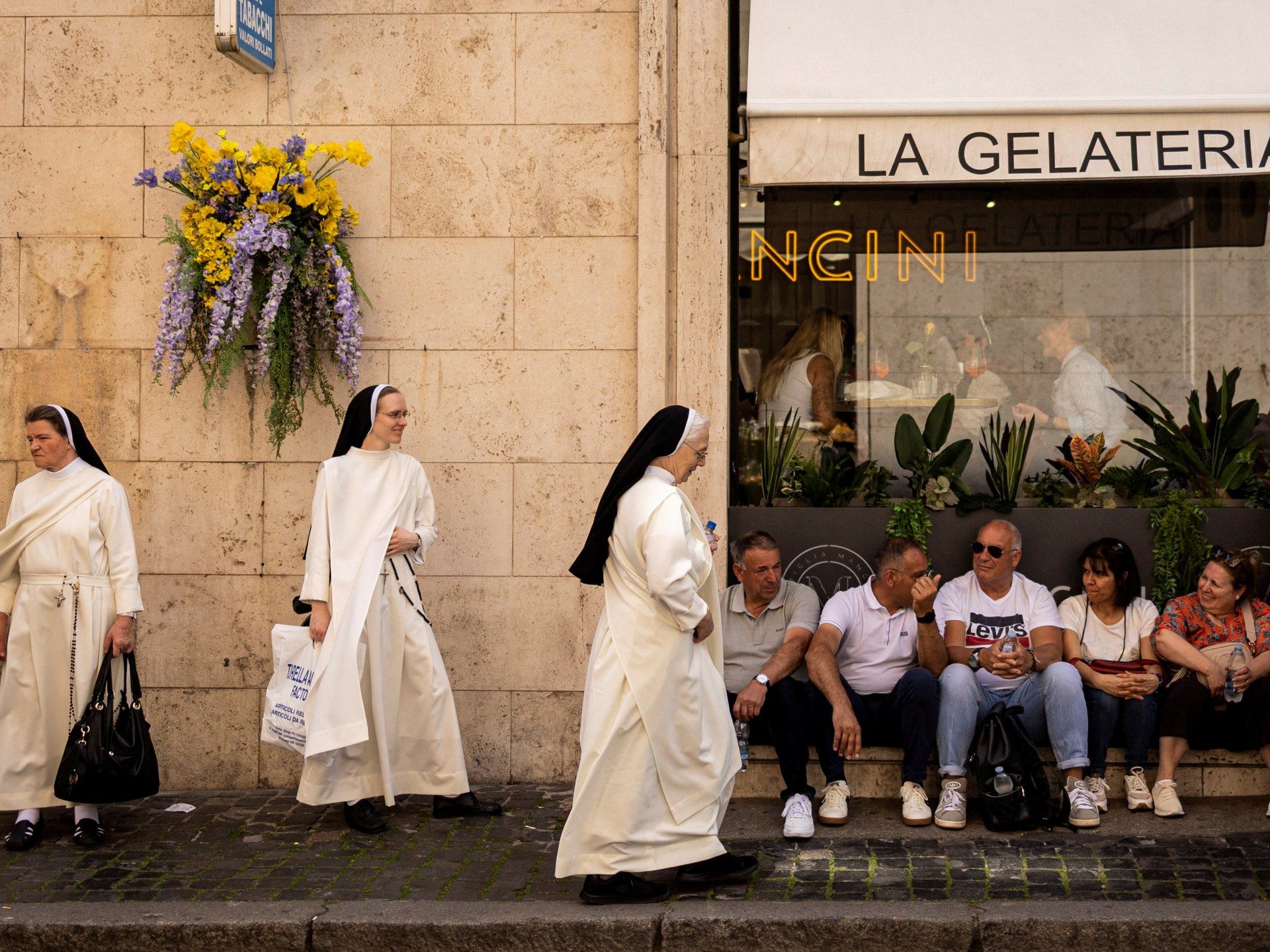
Rome, Italy – When Pope Francis was elected in 2013, he faced loud calls to expand the role of women within the Roman Catholic Church.
To some extent, he delivered. Francis opened key meetings to women; allowed them to senior roles within the powerful central bureaucracy of the Church; and appointed the first female head of the Vatican governorate. For some, these were giant strides for a deeply conservative institution. But to many others, Francis’s moves fell short of what was needed to make the Church truly inclusive.
Now, as cardinals hold daily meetings before beginning the process of voting following his death on April 21, the role of women in the Church remains a divisive issue. When the cardinals finally emerge from their cocoon in the Vatican, will they have picked a pope who will build on Francis’s changes — or someone who might roll them back?
“Women are not holding their breath,” said Kate McElwee, the executive director of Women’s Ordination Conference, a nonprofit focused on women’s rights within Church institutions. “There is some anxiety on whether the next papacy will see some backsliding on the progress because there is a real desire for the project of [women’s] inclusion to continue.”
The incomplete project
Francis’s legacy, when it comes to women in the Church, is still up for debate.
He gave women the power to vote on issues related to the Church at the Synod of Bishops. He also appointed a dozen women to high-ranking positions, including Barbara Jatta as the director of the Vatican Museums, Sister Raffaella Petrini as the president of the powerful Vatican City State, and Sister Simona Brambilla as the first female prefect of a Vatican office overseeing religious orders for both men and women. Overall, throughout Pope Francis’s papacy, the presence of women in the Church’s workforce rose from about 19 percent to 23.4 percent, according to Vatican figures.
But to some, these were just cosmetic changes. The pope did not move forward on the polarising issue of women’s ordination, particularly as deacons or priests.
In the Catholic Church, the role of a deacon involves certain religious functions, such as assisting during mass and performing baptism, but does not allow carrying out most sacraments.
Pope Francis set up two commissions – the first in 2016 and the second in 2020 – to consider whether women could serve as deacons by studying if that was the case in the early centuries of the Church. The report produced by the first group was never released to the public as the commission was not able to agree on the issue, according to Francis, while the second never concluded its work. In 2024, during an interview with US broadcaster CBS, Pope Francis gave a flat “no” to the ordination of women deacons. But a few months later, he signed off on the final document of a synod, saying the issue should remain an “open” question.
“It feels like he unlocked the door but didn’t fully open it,” McElwee said.
And as for women becoming priests, Pope John Paul II in 1994 issued a ban that has since been repeatedly reaffirmed.

All-men’s club
That underrepresentation is in stark display these days as members of an all-male body are discussing the fate of the Church. At pre-conclave meetings in Rome, cardinals are discussing what they believe are the core issues and priorities that a future pope should be able to tackle – from the Church’s sexual and financial scandals and the global crisis of faith to the ties with China and the importance of canon law.
Most of the cardinals who will vote for the new pontiff inside the Sistine Chapel this week have been appointed by Pope Francis and are aligned with many aspects of his agenda, such as social justice, migration and climate change. Yet, observers say they have not spelled out their positions on women in the Church clearly.
In 2023, Cardinal Anders Arborelius, the bishop of Stockholm, Sweden, said it was “important to see that there are other ways” for women to serve the Church “than ordained ministry”. And in a speech at a pre-conclave meeting this week, Beniamino Stella, an Italian cardinal seen as close to the late pope, surprised fellow clergymen by accusing Francis of having created “chaos” in the Church by opening the governance of Vatican offices to men and women who were not part of the clergy.
Sister Marie, a nun who arrived in the Vatican from Marseille, France, awaiting the election of the new pope, agreed.
“Everybody has their role and we are happy to stay at our place, which is not within the hierarchy of the Church,” she said, asking her surname to be withheld. “It [women as deacons or priests] would denaturalise the institution of the Church and the process of transmitting the faith,” she said.
There is also the conservative guard that was outraged by Francis’s decision to appoint nonclerical people to top positions. In an interview with the Italian newspaper Repubblica last week, Cardinal Gerhard Ludwig Muller from Germany, a leading conservative, noted how the Roman Curia – the administrative body of the Roman Catholic Church – is an ecclesiastical body that should not be managed by lay people, likely a criticism of Sister Brambilla’s appointment last year.

A reality already there
Still, the Church cannot afford to ignore the subject of women and their role any more, suggested Sabina Pavone, a professor of history of Christianity at the University of Naples L’Orientale and member of the Italian Society of Historians.
“There is an awareness that this topic needs to be addressed because it continues to be considered one of the hot topics, but how to address it – that is not clear yet,” Pavone said.
The issue of women’s inclusion in the Church is increasingly also a practical matter central to the very functioning of Catholic institutions, she pointed out. Women already run the show in many areas of the world, from managing parishes, supporting local healthcare systems and teaching, while fewer men are entering the priesthood in most places.
“The Church has already changed,” Pavone said. “And the Church has to keep pace with this reality.”
-

 Europe2 days ago
Europe2 days agoFather of crypto entrepreneur rescued from kidnappers after having finger severed
-

 Sports1 day ago
Sports1 day agoScottie Sheffler ties PGA Tour record to claim first victory of 2025 at the CJ Cup Byron Nelson
-
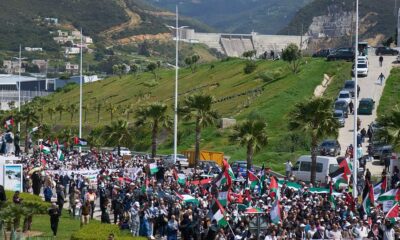
 Africa1 day ago
Africa1 day agoProtesters want Morocco to sever ties with Israel, target strategic ports
-
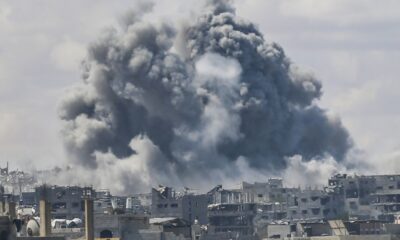
 Middle East1 day ago
Middle East1 day agoIsrael plans ‘conquest’ of Gaza in expanded offensive | Israel-Palestine conflict News
-

 Africa1 day ago
Africa1 day agoDRC: M23 rebels seize strategic town despite peace talks
-
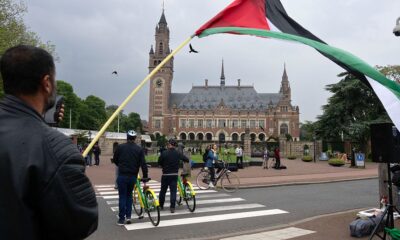
 Africa23 hours ago
Africa23 hours agoDemonstrators angry at ICJ’s decision to dismiss Sudan’s genocide case against UAE
-

 Middle East20 hours ago
Middle East20 hours agoIsrael bombs Yemen’s Hodeidah port after attack near Tel Aviv | Politics News
-

 Lifestyle21 hours ago
Lifestyle21 hours agoWhite House says Harvard will receive no new grants




